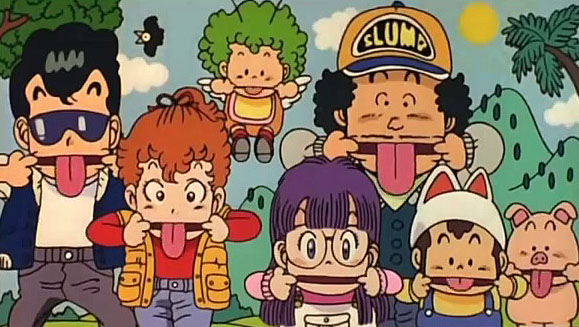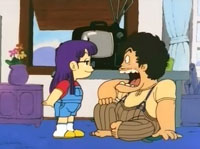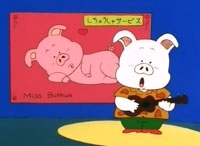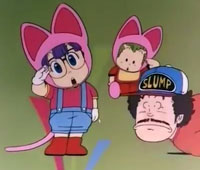
Compared to most shows I have written about, Dr. Slump isn’t exactly the most obscure. After all, it was created by Akira Toriyama, who would have an even bigger success with Dragon Ball few years down the line. However, it never had a big distribution in English-speaking countries, so I figured I owe it to our readers to give a spotlight to the property.
 “Dr. Slump” refers to Senbei Norimaki, an inventor who builds gadgets, having been born to invent. One day he builds a robot girl named Arale. Unlike other robotic humans, she has no superpowers. Arale’s eyes can’t shoot lasers, her stomach can’t shoot cannons, and she can’t fly (Arale wanting to fly is a recurring theme). In fact, the only thing Arale has going for is that she is incredibly strong. She was able to nearly split the Earth in half just by punching the ground.
“Dr. Slump” refers to Senbei Norimaki, an inventor who builds gadgets, having been born to invent. One day he builds a robot girl named Arale. Unlike other robotic humans, she has no superpowers. Arale’s eyes can’t shoot lasers, her stomach can’t shoot cannons, and she can’t fly (Arale wanting to fly is a recurring theme). In fact, the only thing Arale has going for is that she is incredibly strong. She was able to nearly split the Earth in half just by punching the ground.
 Senbei creates Arale as a perfect little girl that can pass off as a human. However, she is anything but perfect. Being a machine, she is incredibly naïve, misunderstanding basic human customs and lacking common sense, which leads to awkward moments with Senbei and other characters. She is also nearsighted, requiring her to wear a large glasses. According to Toriyama, the glasses was meant to be a one-time gag (he claimed it was hard to draw and wanted to get rid of it), but after receiving letters from readers thanking him for it, saying that it made them feel better about their own glasses, he decided to keep it. Despite being a pain to draw, the glasses became Arale’s trademark.
Senbei creates Arale as a perfect little girl that can pass off as a human. However, she is anything but perfect. Being a machine, she is incredibly naïve, misunderstanding basic human customs and lacking common sense, which leads to awkward moments with Senbei and other characters. She is also nearsighted, requiring her to wear a large glasses. According to Toriyama, the glasses was meant to be a one-time gag (he claimed it was hard to draw and wanted to get rid of it), but after receiving letters from readers thanking him for it, saying that it made them feel better about their own glasses, he decided to keep it. Despite being a pain to draw, the glasses became Arale’s trademark.
Senbei has Arale pose as his 13-year old sister, intending to pass her off as a human without anyone knowing that she’s a robot. This proves to be difficult, however. Due to Arale’s naïve nature, she would do things that no normal human can do, from playing with her head (she would literally detach her head and throw it around) to displaying her aforementioned superhuman strength. Even her own anatomy can be a drawback; one episode had Arale wanting a bellybutton due to other kids at school making fun of her for not having any while changing clothes at the gym class (due to a misunderstanding, Senbei thought Arale was asking for genitals, which proved difficult since he has never seen a nude female before).
 In spite of this Senbei is adamant that he can pass her off as a human. After creating her, he enrolls Arale in a school that his crush Miss Midori teaches. Arale befriends two rebellious teens, Akane, a blond girl whom Senbei regards as a bad influence, and Taro, the “bad boy” who wears sunglasses all the time. Another recurring character is Gatchan, a green-haired creature with wings hatched from an egg that Senbei brought home when he time traveled to pre-historic times (it was never made clear if the character is male or female). It was revealed that Gatchan was planted by God to destroy humanity, which failed due to Senbei entering its life.
In spite of this Senbei is adamant that he can pass her off as a human. After creating her, he enrolls Arale in a school that his crush Miss Midori teaches. Arale befriends two rebellious teens, Akane, a blond girl whom Senbei regards as a bad influence, and Taro, the “bad boy” who wears sunglasses all the time. Another recurring character is Gatchan, a green-haired creature with wings hatched from an egg that Senbei brought home when he time traveled to pre-historic times (it was never made clear if the character is male or female). It was revealed that Gatchan was planted by God to destroy humanity, which failed due to Senbei entering its life.
The series takes place in a Penguin Village, a place where humans, anthropomorphic animals, robots, monsters, and even mythical creatures exist. Every morning, when the sun rises, he is seen brushing his teeth, one of the running gags. Mr. Pig is a side character seen from time to time; in the first opening theme song, he would say different things each episode, sort of a couch gag for the show. Akira Toriyama himself would appear in the show, sometimes as a robotic bird (‘Tori’ in Toriyama is Japanese for bird). Senbei’s rival is Dr. Mashirito, an evil mad scientist.
 While Dragon Ball had its comedy moments, Dr. Slump is a pure gag series. Sexual humor is the norm, mostly stemming from Senbei’s perverted nature. He who would sometimes create gadgets just so he can look at women (particularly Miss Midori) naked. Pop culture parodies (both American and Japanese) are rampant, with characters like Suppaman, an overweight Superman lookalike who is very weak and has no real superpower. In short, he is totally useless. Suppaman is most often seen flying in the background. A little creature that looks like Kamen Rider (a tokusatsu staple created by cartoonist Shotaro Ishinomori) is also present in the backgrounds, perching on a tree like a cicada. Puns and toilet humors are also a common, which got carried over to the anime.
While Dragon Ball had its comedy moments, Dr. Slump is a pure gag series. Sexual humor is the norm, mostly stemming from Senbei’s perverted nature. He who would sometimes create gadgets just so he can look at women (particularly Miss Midori) naked. Pop culture parodies (both American and Japanese) are rampant, with characters like Suppaman, an overweight Superman lookalike who is very weak and has no real superpower. In short, he is totally useless. Suppaman is most often seen flying in the background. A little creature that looks like Kamen Rider (a tokusatsu staple created by cartoonist Shotaro Ishinomori) is also present in the backgrounds, perching on a tree like a cicada. Puns and toilet humors are also a common, which got carried over to the anime.
Even though the series is named after Senbei, the real star is Arale-chan. It’s not unusual for a secondary character to take over the series, but in Dr. Slump’s case, it was due to an editorial mandate. Kazuhiko Torishima, who was Toriyama’s editor at Shonen Jump at the time, favored Arale and asked that she would become the main star. Toriyama later admitted that this turned out to be for the good.
 Dr. Slump debuted on Weekly Shonen Jump in January 1980. The comic was a hit, giving Akira Toriyama a push in his career. An anime adaptation came out a year later, courtesy of Toei Animation. The show was called Dr. Slump Arale-chan (Dr. Slump and Arale) and it began in April 8, 1981 on Fuji Television. The anime was a ratings hit and it even out-lived the original manga, which ended on 1984; the anime lasted until February 19, 1986. Altogether, 243 episodes were made. The following week, Fuji Television replaced the show with Dragon Ball.
Dr. Slump debuted on Weekly Shonen Jump in January 1980. The comic was a hit, giving Akira Toriyama a push in his career. An anime adaptation came out a year later, courtesy of Toei Animation. The show was called Dr. Slump Arale-chan (Dr. Slump and Arale) and it began in April 8, 1981 on Fuji Television. The anime was a ratings hit and it even out-lived the original manga, which ended on 1984; the anime lasted until February 19, 1986. Altogether, 243 episodes were made. The following week, Fuji Television replaced the show with Dragon Ball.
However, that wasn’t the end for Dr. Slump yet. During the show’s run, four theatrical films were released annually from 1982 to 1985. Five more movies were made in the 1990s (two in 1993, another two in 1994, and one in 1999). In addition, Arale made a crossover appearance in Dragon Ball, helping Goku on one of his adventures.
A second television series, consisting of 74 episodes, was later made by Toei, again airing on Fuji Television from November 26, 1997 to September 22, 1999. Notably, this show was one of the first anime to have its drawings colored digitally, Toei having made a switch from painted cels around this time. Finally, a five-minute short film was made in 2007, released theatrically as a bonus with One Piece Movie: The Desert Princess and the Pirates.
There was an attempt to dub the series in English back in the 1980s, with the first episode dubbed, but it didn’t get picked up. The original manga did eventually have an English-language release, courtesy of Viz Media. In 2013, Discotek Media licensed the first five feature films for an American release. Hopefully the original show will have its release here as well.
First episode with English subtitles


 Charles Brubaker is a cartoonist originally from Japan. In addition to his work for MAD Magazine and SpongeBob Comics, he also created Ask a Cat for GoComics. You can also follow him on his Tumblr page.
Charles Brubaker is a cartoonist originally from Japan. In addition to his work for MAD Magazine and SpongeBob Comics, he also created Ask a Cat for GoComics. You can also follow him on his Tumblr page.











































I haven’t seen this series yet despite knowing of it for a long time. It’s a kid’s show but always looked like a fun one. The Toriyama I read and watched always had a good chance at ticking my funny bone.
Dragonball definitely seemed like a transition series between the pure gag elements of Dr Slump and the more serious shounen aspect of DB. The first 13 episodes look like a complete gag series parody of Journey to West. The series doesn’t remotely play it straight until later on.
One thing that carried over from Dr. Slump into Dragon Ball was the use of a tournament the characters enter a few times in the series. In Dr. Slump there was a Grand Prix race around Penguin Village that was done a few times and gave Toriyama an excuse to dedicate more than a single chapter to it. This would pave the way for the “Tenkaichi Budokai” (referred to as a “Martial Arts Tournament” in the English dub of the anime) seen in Dragon Ball. That’s where Dragon Ball grew out of it’s Monkey King origins into what it would become thereafter.
The C/FO loved “Dr. Slump and Arale-chan” for its gonzo humor. Even untranslated (it was one of the TV programs that we traded video tapes for, recorded right off the Japanese TV broadcasts), it was hilarious. Its version of Superman was named Suppaman, and since “suppa” sounds like the Japanese word for sour pickles, he was always eating sour pickles. I forget the real name for one of our favorite episodes, a parody of the American movie “Quest for Fire”, but we called it “Quest for Toilet Paper” for obvious reasons.
The humor wasn’t only on the screen. One time Akira Yoriyama and his manga editor, Kazuhiko Torishima (“bird mountain” and “bird island”), got into an argument that escalated into a “saving face” contest. This was supposedly real, not a publicity stunt. All of the other manga tankōbon books from “Shonen Jump” had photographs of their authors, so Torishima asked Toriyama for one of himself. At that time Toriyama was making a big deal of being a Man of Mystery – he usually drew himself wrapped like an Egyptian mummy, or as an anthropomorphic bird on a mountaintop – so he said that he did not want his photo published. Torishima turned the request into an order. Toriyama refused. Neither would back down. Finally it turned out that Toriyama’s contract required him to follow Torishima’s order. Toriyama said, “All right, but if I have to send you a photograph of myself, I’ll send you one that you can’t publish.” Torishima replied, “You send it and we’ll print it!” Toriyama sent a photo of himself urinating into his toilet, and it was published.
He got balls there!
Way back when the manga was still new, I remember Frank Miller commenting on how much he loved it.
This was my favorite anime as a kid! I used to borrow tapes of it from my Japanese school every night, but I was always bummed none of my American friends knew it. Recently though, it seems like its been getting pretty popular here.
DR. SLUMP was a highly popular show here in Spain (particularly in the Catalonia area, where it aired, dubbed into Catalan, on the TV3 network in the late 80’s, being often re-run thereafter), as well as in France and Italy, and later in Mexico and other Latin American countries. It paved the way for Toriyama’s even more successful (but slightly less creative and funny) DRAGON BALL.
It does seem kinda weird how much the opposite it was for us in the Anglosphere not to have had Dr. Slump first while the rest did. The English pilot dub referred to in the article looked like something I could picture Nickelodeon airing in the late 80’s had they had the nerve to pick up such an unusual show like that (it hasn’t stopped them before).
Here’s a recent article about the manga itself from translator Jason Thompson
http://www.animenewsnetwork.com/house-of-1000-manga/2013-10-17
Akira Toriyama seems far more at home writing and drawing comedy then action so it’s pretty funny to see people complain especially non-anime fans how terribly drawn Dragon Ball Z is. Toriyama is an excellent artist in his own right and when you have a multitude of animators trying to reinterpret his art style for a weekly animated series it’ll end up looking like crud a lot of the time. Still when he was at his height drawing Dragon Ball he was still able to churn out great fight scenes.
I really wish more of his stuff was in print in English despite the seemingly never ending popularity of Toei’s Dragon Ball Z but I guess fandom is a fickle thing.
And you can see how some people were turned off from the new “Battle of Gods” movie simply because it is close to Toriyama’s humor than the action they’re more use to seeing.
I really wish more of his stuff was in print in English despite the seemingly never ending popularity of Toei’s Dragon Ball Z but I guess fandom is a fickle thing.
At least we got the manga at all. I’m sure you can still find the volumes out there. Fandom sucks by the way.
Wow, this really sounds interesting–good sound effects, too. Sure wish that an English-language version of the series was available.
We’ll always have this pilot (which sadly edits some scenes that have Japanese signage visible and a number of gags like Senbei dressing up like a woman to buy Arale panties at a dept. store).
https://www.youtube.com/watch?v=dxJh5pRzO-Q
I had the great fortune of being in Japan (in the Air Force) when Dr. Slump was still on the air; along with Urusei Yatsura it was a show I never missed. It’s still one of my favorite anime series, but I just don’t see how it can properly translate for an American audience. And a lot of the toilet humor, which would have been too risque` for an American release in the 80’s, would, I think, kinda fall flat now. It comes across as a children’s show but I don’t think many parents would want their kids seeing things like how Arale uses a Gatchan to make ice cream!
I’m happy to enjoy the series for what it is, even having to still watch it in the original Japanese!
It is funny when you have to consider this show’s idea of excrement is that it’s multi-colored with a face, arms and legs (almost thought I was seeing a dessert topping the way it appears, nothing like South Park’s “Mr. Hanky”).
The rest of the world just sorta laughs at us for being so far behind the pack!
It certainly added distinction to her character I don’t think we’d have if she had perfect vision.
And to think of the latest anime shows to pull stunts like this and we just simply hand wave it away, especialy when your 13 year olds look half their ages!
that was a brilliant episode in it’s own right!
You forgot Taro’s little brother “Pesuke”, who wears such a babyish cat-ear hat that he will continue to wear all his life (but then I’m spoiling too much).
what will happen is for Gatchan to continue multiplying until the entire world is covered with it’s spawned descenents, whose job essentially is to destroy technology whenever possible, so God’s work still goes on, if not via a different path.
And to think he would eventually marry Arale’s teacher anyway regardless of Senbei’s perverted beginnings.
Incidentally, many of the names of the characters in the show reference to many familiar words or things in the Japanese language I’m sure plenty of us wouldn’t pick up on. One I liked noticing was discovering Midori’s name and her profession as a school teacher references the popular Japanese version of “Romper Room” that aired in Japan from 1963 to 79 on Nippon TV (NTV). The teachers (or hostesses) on the show were always referred to as “Miss Midori”. It wouldn’t surprise me if Toriyama had saw it a lot as a young boy and simply used it as the name of teacher in his manga. There’s a callback to it in one chapter referring to the “Do Bee/Don’t Bee” lessons made familiar in the show.
http://www.geocities.jp/kindanhm/ronper.html
The ’97 series as I call it isn’t too bad either as a start into the use of digital ink & paint. It still holds up pretty well I feel even with it’s frantic opening theme song, though the character designs get that upgrade to resemble the look of Dragon Ball GT that preceeded it.
https://www.youtube.com/watch?v=6AFAhnpLENs
Then there was the one lucky chance viewers in Hawaii got to see the show courtesy of the cable channel Nippon Golden Network, with English subtitles (or what subtitles were were, it was very simple and not every line of dialogue was translated), but it was enough of an excuse for those to trade videotaped copies of the broadcasts to send to their pals back on the mainland!
For more on Dr. Slump, here’s a good audio primer to listen to!
http://daizex.db-destiny.net/Daizenshuu_EX_-_Episode_0288.mp3
Petition to english dub Dr Slump link below;
https://www.change.org/funimation-toei-animation-akira-toriyama-dr-slump-funimation-english-dub-petition